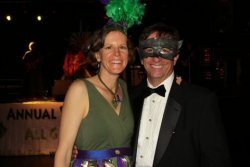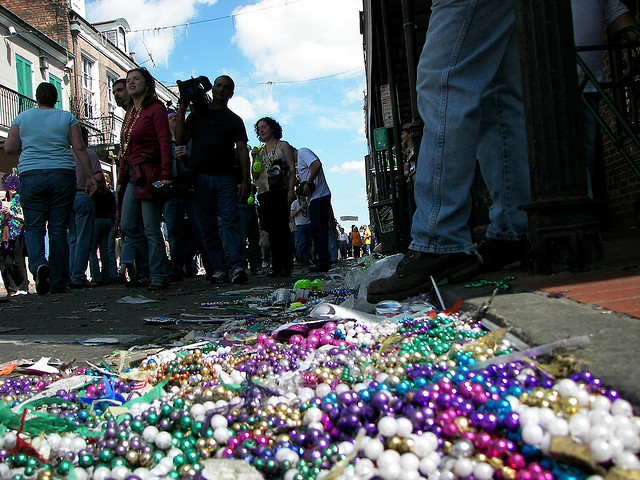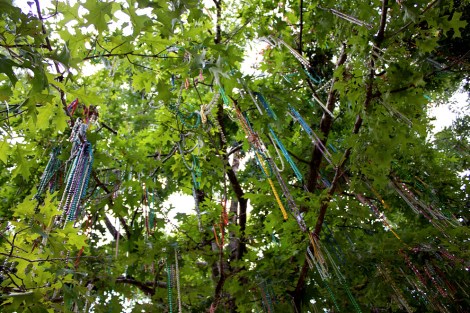Guess how many beads a “super krewe” throws out in a single city block? (“Krewes” are the groups that put on New Orleans Mardi Gras parades — the super krewes first appeared in the ’70s, upping the ante with more floats, celebrities, and presumably a big jump in bead volume.)
10 pounds?
100 pounds?
Try 15 tons. That’s some $56,000 in little plastic balls, hitting sky, then streets, then gutters, then the Louisiana coastline, for every single block of the parades. That’s what New Orleans residents Holly and Kirk Groh estimate, based on parade attendance figures and a Tulane study [PDF].

Neil Cooler
Sitting on the sidewalk for the parades in 2011, the Grohs watched the cascading plastic beads and all Holly could think about was all the waste.
Most of those strands of beads tossed out to paradegoers (extra if you show some skin) are made of petroleum products. For a city that is still recovering from the Deepwater Horizon explosion that leaked oil all over the Louisiana coastline, that struck her as especially tragic. “I think this is in other people’s hearts that it doesn’t quite feel right,” Holly Groh says. “But I think, as a group, we haven’t quite known what to do.”
The way Groh figured it, you can’t fight Mardi Gras — you have to change it. Last year, she and her husband, along with a group of friends and volunteers, launched Verdi Gras. They help recycle that trash on the parade route, encourage the krewes to reduce the amount of non-recyclable plastic they toss, and throw their own masquerade ball featuring local food and booze.
“We wanted to show that we could do this with a spirit of fun and community and joie de vivre that’s in the spirit of New Orleans,” Groh explains.
Here’s her story:

Holly and Kirk Groh.
Q. What inspired you to green up Mardi Gras?
A. We lost our home in Katrina and we watched the insides of everybody’s houses floating down the streets. We were probably sensitive to the environment, but then, to us, it really put an emphasis on the fragility of Louisiana and New Orleans. What happened then was the BP oil spill came. It was just traumatic. We shop at the farmers market and saw how it affected families who depended on the water for their living.
Then it came time for Mardi Gras that year. The trash always bothered us horrendously before, but this year in particular, we sat with a bunch of our friends and family and we all had the same reaction: There was absolutely no change. We were still surrounded by huge amounts of petroleum products — the bags the beads came in, the beads, the Mardi Gras cups; it just kind of made us sick to our stomachs. We came up with a mission that we wanted to preserve our unique cultural heritage and preserve our beautiful environment.
Q. But is it really Mardi Gras if people aren’t launching beads into throngs of people?
A. Our motto is “it’s about the show, not the throw.” The throws [aka giant bead tosses] are not part of Mardi Gras history. It showed up in the last 20-25 years. We feel like the emphasis for us is to say we can have a really great party without all this stuff. Have you ever been to Mardi Gras? It’s tremendous; there is a huge amount of stuff.
Q. How does one throw an environmentally friendly masquerade ball in full New Orleans style?
A. Our dishes were all locally prepared, with local foods — brown rice grown here, vegetables from the farmers market. We had locally crafted alcoholic drinks and non-alcoholic drinks. There were great bands — all local music and musicians. The beneficiary this year was Arc [a nonprofit devoted to helping people with intellectual disabilities]. They pick up the beads and recycle them. You can’t melt them down because they’re made of carcinogenic products. So they are cleaned off, repackaged, and sold back to the krewes to use the next year.
Q. Tell me about that gorgeous masquerade ensemble.
A. I had a dress that was recycled that a costume maker in town had. It was kind of a criss-cross thing in the front with beading along the fabric. I had a coat that looked like something Prince could have worn from a secondhand shop, and then a cone-shaped hat that [the costumer] made.
Q. Into your second year, how successful is Verdi Gras?
A. We have about 30 to 40 volunteers [to help with recycling]. The Verdi Ball was more intimate than we would have liked, about 120 or so attendees. It was smaller, but sweet. We are trying to think creatively about working with a church or a school or a neighborhood, hoping that the krewes will reduce the amount that they throw. We want people to think more about these things so that our precious New Orleans survives a few more generations.




